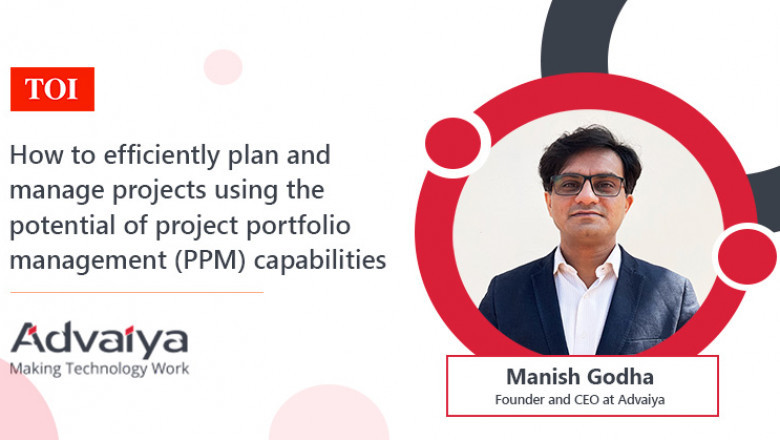views

A Project Portfolio Management (PPM) system’s goal is to successfully manage all of the initiatives a firm to survive and thrive. These initiatives may be related to investments, innovations, or improvements. Any company would have centralised or decentralised project management offices (PMO), whether formally set up or not, in charge of planning and monitoring these efforts. Organisations can successfully empower their PMOs and executive management by adopting project portfolio management.
Moreover, managing different but interdependent projects within the broader portfolio enables businesses to achieve strategic objectives. With the help of the project portfolio management processes, businesses can plan for outcomes with more confidence and effectively allocate resources. Project managers and PMOs can take proactive steps to manage risks rather than waiting to act until projects are already doomed by having a better grasp of hazards across projects and portfolios. With the help of the essential components of project portfolio management, businesses can:
- Prioritise projects with the highest strategic alignment and potential value
- Increase project delivery success
- Decrease overspend and inefficiencies
- Make smarter decisions
- Manage change
Implementing PPM in your organisation can give significant advantages in terms of cost-saving and oversight. Organisations with established PPM processes are in a better state to make more informed and data-driven decisions. Without a question, ensuring PPM procedures and systems takes time, a certain set of skills, and organisation-wide adoption and support. A methodical strategy can ensure better adoption and outcomes. Here is how you can successfully implement project portfolio management system for your organisation:
Set the strategy: Establishing a strategic action plan is essential for implementing PPM systems and procedures inside the firm. A structure within which organisational activities can be organised must be created to accomplish this. This entails developing the appropriate organizational frameworks, accountability systems, and teams. Additionally, it creates a taxonomy or category structure for the organization’s many initiatives. Also, it is important is to define the ways in which success of a project can be measured. This will enable your company’s initiatives to be driven by organizational goals and values.
Win executive support: Some individuals will resist the procedural changes that introducing PPM necessitates. You must identify the important stakeholders and obtain their early support for PPM in order to decrease this friction. Starting at the top of your organisation, support should permeate every division. PPM will influence how each team approaches projects, so take the time to collaborate with the proper individuals right away. Senior executives make significant decisions about projects at the portfolio level as part of PPM’s top-down methodology. In order to gain organisational support for PPM early on, it is necessary to identify key stakeholders and communicate the vision effectively.
Collect and evaluate project data: Determining the approaches and procedures being used for important PPM components can help set up better PPM practices. This covers coming up with ideas, assessing them, choosing initiatives, allocating resources, tracking, etc. Some of these can be casual and drastically differ across the organisation. In keeping with the overarching strategic approach, it is crucial to define common processes, jargon, and methodologies. This may involve conducting an extensive survey and gathering data for current initiatives and those that are in the works. Reviewing the organisation’s entire set of procedures is made possible by this. Critical data about ongoing and upcoming projects, projects aligned to specific goals, accountabilities and involvement and time and cost outlays should be addressed by the data gathered.
This makes it possible to analyse these initiatives as a portfolio and spot problems like duplication, interdependence, high-risk ventures, and resource overallocation.
Initiate PPM adoption: At this stage, your organisation is ready for a more sophisticated approach to organizing and analysing its portfolio of projects. Here, a PPM automation system should be introduced as a standard and unified PPM system (let’s use Microsoft Project Online as an example). The time is right for an essential implementation that incorporates the specified projects, tests the method for identifying and evaluating project ideas, includes the strategic taxonomy, and makes it possible to follow project progress. This gives PMOs and upper management the ability to view a variety of projects as portfolios and benefit from better visibility and control. Here, user adoption—and the resulting involvement, training, and engagement of various teams—as well as business intelligence (BI), can help grow PPM deployment which offers simple and useful visibility as pertinent to the stakeholders, are key factors.
Executing PPM implementation: Successful project management goes beyond tracking and visibility. Project proposals, planning and budgeting, vendor management, regulatory, quality, and people-related elements must all be carefully taken into account. Implementing portfolio selection systems, integrating PPM systems with financial, HR, or other operational systems, and expanding the implementation to cover more departments, or regions may be necessary for this. It may also be appropriate for an organisation to use portfolio prioritisation tools to optimise on budgets and business gains. It is possible to integrate more automation and insights, such as targeted or comprehensive reports, automated workflows, or automated actions linked to other organisational systems.
A learning and adoption plan must be created after implementation. Identify and address any issues or redundancies that come up post-implementation. Look for possibilities to improve your PPM approach across the short, medium, and long terms. This agile strategy makes sure the portfolio stays in line with strategic objectives and gives us a chance to regularly get input from important stakeholders.
Despite the fact that project portfolio management cannot be implemented in a single day, the benefits are significant, swift, and important. In essence, project portfolio management is a collaborative approach to ensuring that strategic objectives are fully and successfully addressed.
Source: https://www.advaiya.com/aspl-media/efficiently-plan-and-manage-projects-using-the-ppm-capabilities/












